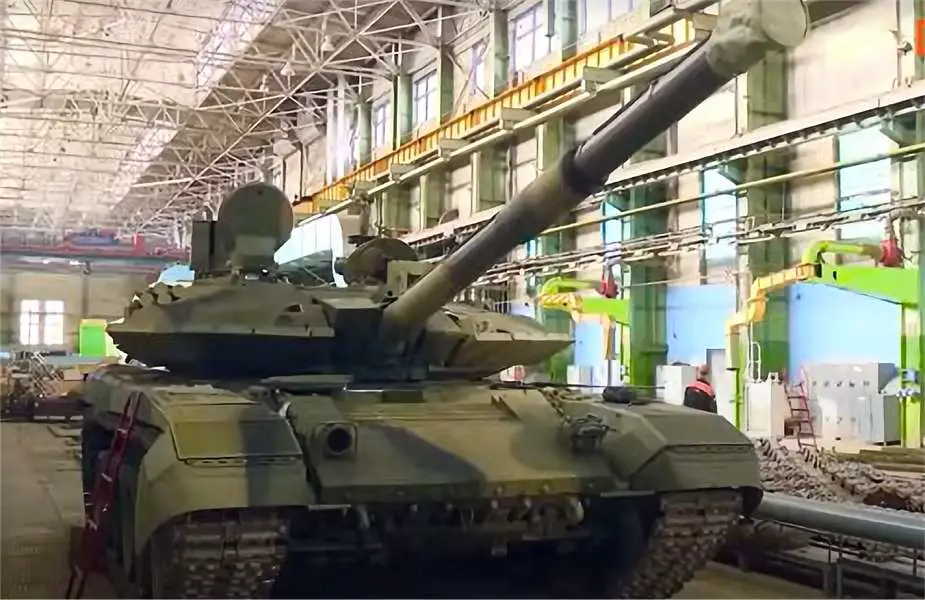Breaking news
Russia Prioritizes Military Equipment Delivery for Ukraine War Drops to Third in Arms Exports.
In a significant shift in global arms export dynamics, Russia has descended from its longstanding second-place ranking to third. This information comes from a detailed report by the Stockholm International Peace Research Institute (SIPRI), as highlighted in a publication on Twitter by the British Ministry of Defence (MoD) Intelligence service on March 17, 2024. According to the latest data released by SIPRI, Russian arms exports experienced a drastic reduction of 53% between the comparative periods of 2014-2018 and 2019-2023.
Follow Army Recognition on Google News at this link

Russia escalates tank production in response to the Ukraine conflict. (Picture source: TASS)
This downturn in arms exports is further highlighted by a year-over-year comparison, revealing a 52% decrease in volumes from 2022 to 2023. The reach of Russian military hardware has also notably contracted, with only 12 countries listed as recipients of major Russian arms in 2023, a steep decline from the 31 nations recorded in 2019.
Several key factors contribute to this dramatic fall. The ongoing military operations in Ukraine have forced Russia to reallocate its arms domestically to compensate for significant battlefield losses. This internal prioritization has naturally led to a decrease in the volume of exports. Additionally, the international community's response to Russia's actions in Ukraine has also played a critical role. The risk of sanctions and the global condemnation of Russia's involvement in the conflict have deterred potential customers, leading to a reduced demand for Russian arms on the global market.
This turn of events marks a pivotal moment in the international arms trade, reshaping the landscape of global military exports. The implications of Russia's reduced arms export capacity extend beyond economic repercussions, potentially altering strategic alliances and defense collaborations on the international stage.
The British MoD Intelligence Service, which published the SIPRI findings on March 17, 2024, notes that this decline in Russian arms exports reflects broader geopolitical shifts and underscores the far-reaching impact of the conflict in Ukraine on global military and defense trade networks.
In a bid to reinforce its military capabilities amidst the ongoing conflict in Ukraine, Russia has significantly increased the production of military equipment and tanks. This development comes in light of the stark decline in Russia's arms exports, which has seen the country drop to third place in the global arms export rankings as reported by the Stockholm International Peace Research Institute (SIPRI).
Despite a 53% fall in arms exports between the periods of 2014-2018 and 2019-2023 and a subsequent reduction in the number of countries receiving Russian military hardware, the domestic ramp-up in production underscores Moscow's strategic shift towards self-sufficiency and operational readiness on the battlefield. The decreased export volumes, coupled with the need to offset continuous battlefield losses in Ukraine, have prompted Russia to prioritize the enhancement of its own military arsenal over international sales.
This increase in the production of military equipment, particularly tanks, is a direct response to the sustained military engagements in Ukraine. Russia's defense industry is reportedly operating at an accelerated pace to supply the front lines with essential military assets, aiming to replenish and enhance its forces engaged in the conflict. This move is not only aimed at maintaining the intensity of military operations but also at adapting to the evolving tactical requirements of the war.
The shift towards bolstering domestic military capabilities reflects the broader implications of the conflict in Ukraine for Russian defense policy and strategy. As international sanctions and global condemnation limit Russia's arms trade, the focus on internal military preparedness signifies a strategic recalibration in response to both immediate battlefield needs and long-term geopolitical challenges.
Furthermore, the increased production of military equipment and tanks indicates Russia's determination to sustain its military efforts in Ukraine, despite facing international isolation and economic pressures. This development may have significant implications for the conflict's dynamics, potentially influencing the strategic calculations of involved parties and international stakeholders alike.
Defense News March 2024























